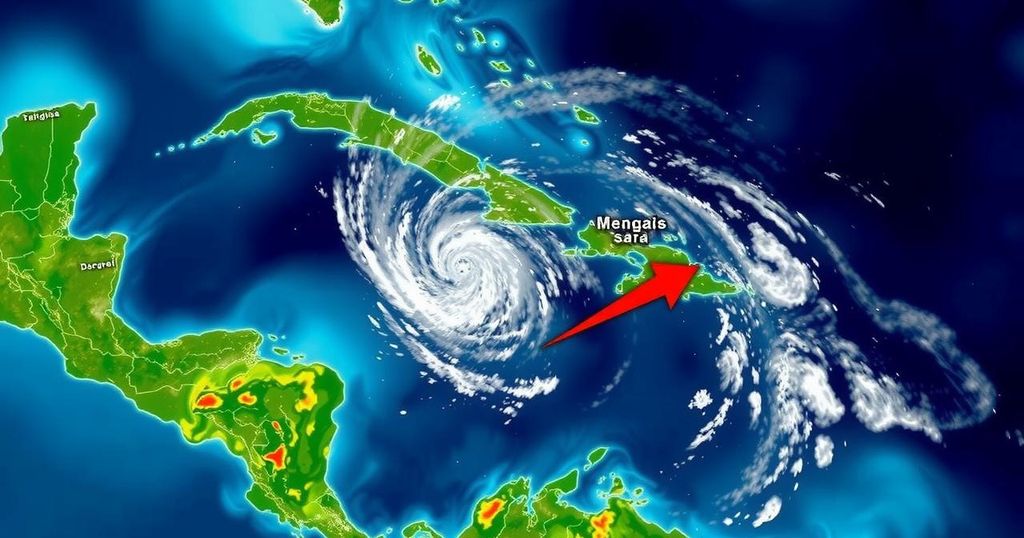Tropical Storm Sara Threatens Honduras Amid Climate Concerns

Tropical Storm Sara formed on November 14, 2024, becoming the 18th named storm of the hyperactive hurricane season, expected to bring severe rainfall and flooding to Honduras. Historical precedents highlight the region’s vulnerability to catastrophic storms, necessitating continued attention to climate change and disaster preparedness.
On November 14, 2024, Tropical Depression 19 intensified into Tropical Storm Sara over warm waters of the Western Caribbean. This event marked the 18th named storm in the ongoing storm season, which has surpassed average statistics and is designated as hyperactive, having accumulated cyclone energy levels 31% above normal. The name ‘Sara’ has not been used since it was introduced following the catastrophic impacts of Hurricane Sandy in 2012. As of Thursday afternoon, the storm was located approximately 50 miles northeast of the Nicaragua-Honduras border, with sustained winds of 40 mph. It is projected to approach landfall in northeastern Honduras, potentially resulting in severe rainfall between 10 to 20 inches, leading to dangerous flooding and mudslides. After a considerable lull in activity earlier in the season, the Atlantic has seen a surge of named storms since late September, setting a record for this time of year. Forecast models indicate that Tropical Storm Sara will initially drift westward near the coast of Honduras before eventually moving towards the Yucatan Peninsula due to a ridge of high pressure. Despite conditions being somewhat conducive for strengthening, the interaction with land is expected to inhibit significant intensification. Nevertheless, the geographical features of Honduras may exacerbate the rainfall situation. Historical context surrounds such storms, as previously, Hurricane Mitch in 1998 led to devastating rainfall and loss of life, while Hurricanes Eta and Iota in 2020 caused extensive damage and economic repercussions in the region. These events underscore the vulnerabilities faced by Honduras, particularly with ongoing challenges from climate change and natural disasters. Recent reports indicate that the impacts of Eta and Iota affected millions and severely hampered economic recovery. As migration patterns shift in response to environmental crises, the discourse emphasizes the necessity of increased awareness and action regarding climate change. Bringing this narrative into the present, Tropical Storm Sara serves as a reminder of the ongoing risks that climate threats impose on already vulnerable areas, particularly as the region continues to navigate recovery challenges from past hurricanes. In summary, the emergence of Tropical Storm Sara illustrates the heightened risks associated with late-season storms in Honduras, revealing ongoing climate challenges. With severe rainfall expected and historical precedents of disastrous impacts, the necessity for robust disaster preparedness and climate adaptation strategies becomes increasingly evident.
The history of tropical storms and hurricanes impacting Honduras reveals a stark narrative of devastation and recovery challenges. The region has faced severe weather events such as Hurricane Mitch in 1998, which resulted in unparalleled loss of life and catastrophic flooding, and more recently, Hurricanes Eta and Iota in 2020, which inflicted significant economic damage and calamity. This historical context forms a crucial backdrop as current weather phenomena like Tropical Storm Sara emerge, elevating concerns about environmental vulnerabilities exacerbated by climate change.
Tropical Storm Sara presents both immediate risks and long-term implications for Honduras as the nation grapples with its legacy of vulnerability to extreme weather events. The anticipated heavy rainfall raises alarm over potential flooding and mudslides, while the historical context underscores the critical need for preparedness against climate-induced challenges. As global attention on climate issues grows, it is imperative for societies to learn from historical lessons and bolster their resilience against future storms.
Original Source: yaleclimateconnections.org






